Multiple Choice
Identify the
choice that best completes the statement or answers the question.
|
|
|
1.
|
The movement of substances into and out of a cell without the use of energy
is called ___________.
a. | active transport | b. | passive transport | c. | exocytosis | d. | endocytosis |
|
|
|
2.
|
Mechanism that moves materials across the cell membrane, against the
concentration gradient. Using energy, the directional movement of substances from an area of low
concentration to an area of high concentration is called ___________.
a. | active transport | b. | passive transport | c. | exocytosis | d. | endocytosis |
|
|
|
3.
|
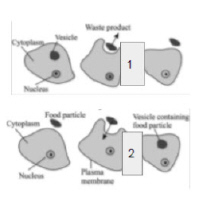 Which form of transport is number
1? a. | active transport | b. | passive transport | c. | exocytosis | d. | endocytosis |
|
|
|
4.
|
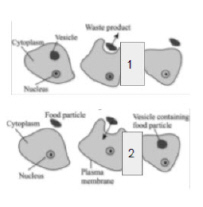 Which form of transport is number
2? a. | active transport | b. | passive transport | c. | exocytosis | d. | endocytosis |
|
|
|
5.
|
A form of active transport that removes materials from the
cell.
a. | active transport | b. | passive transport | c. | exocytosis | d. | endocytosis |
|
|
|
6.
|
Active transport that brings materials into the cell without passing through
the cell membrane.
a. | active transport | b. | passive transport | c. | exocytosis | d. | endocytosis |
|
|
|
7.
|
Chemical Messengers that regulate some body functions in multicellular
organisms and to help balance to maintain homeostasis.
a. | active transport | b. | passive transport | c. | hormones | d. | endocytosis |
|
|
|
8.
|
Which of the following is not a function of Hormones?
a. | Chemical Messengers that regulate some body functions in multicellular organisms and
to help balance to maintain homeostasis. | b. | Control of movement of oxygen and to cells and
the removal of carbon dioxide from cells | c. | Maintenance of the internal temperature of an
organism and the regulation of fluids | d. | Process by which substances move directly
through the cell membrane |
|
|
|
9.
|
Process by which substances move directly through the cell membrane?
a. | Osmosis | b. | Faciliated diffusion | c. | Diffusion | d. | Hormones |
|
|
|
10.
|
Process by which movement of water from an area of higher water concentration to
an area of low water concentration through a semi-permeable membrane.
a. | Osmosis | b. | Faciliated diffusion | c. | Diffusion | d. | Hormones |
|
|
|
11.
|
Process by which involves the help of a channel protein to move a substance from
one side of the cell membrane to the other
a. | Osmosis | b. | Faciliated diffusion | c. | Diffusion | d. | Hormones |
|
|
|
12.
|
Selectively permeable, meaning that only certain substances can go
through.
a. | Osmosis | b. | Faciliated diffusion | c. | Semi-permeable | d. | Hypertonic |
|
|
|
13.
|
Higher concentration of dissolved solute
a. | Osmosis | b. | Hypotonic | c. | Isotonic | d. | Hypertonic |
|
|
|
14.
|
Lower concentration of dissolved solute
a. | Osmosis | b. | Hypotonic | c. | Isotonic | d. | Hypertonic |
|
|
|
15.
|
When the concentration of dissolved solutes is the same inside the cell as it is
outside the cell.
a. | Osmosis | b. | Hypotonic | c. | Isotonic | d. | Hypertonic |
|
|
|
16.
|
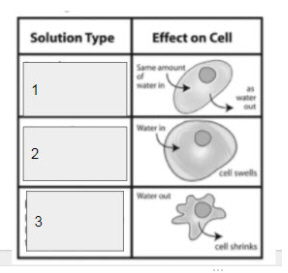 Which situation is Solution type 1? a. | Osmosis | b. | Hypotonic | c. | Isotonic | d. | Hypertonic |
|
|
|
17.
|
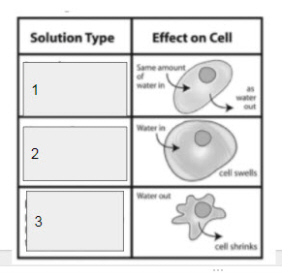 Which situation is Solution type 2? a. | Osmosis | b. | Hypotonic | c. | Isotonic | d. | Hypertonic |
|
|
|
18.
|
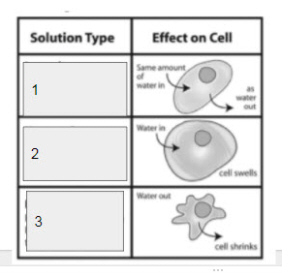 Which situation is Solution type 3? a. | Osmosis | b. | Hypotonic | c. | Isotonic | d. | Hypertonic |
|
|
|
19.
|
 Which process is taken place across the cell
membrane in situation 1? a. | Osmosis | b. | Simple diffusion | c. | Diffusion | d. | Facilitated
diffusion |
|
|
|
20.
|
 Which process is taken place across the cell
membrane in situation 2? a. | Osmosis | b. | Simple diffusion | c. | Diffusion | d. | Facilitated
diffusion |
|
|
|
21.
|
 Which process is taken place across the cell
membrane in situation 3? a. | Osmosis | b. | Simple diffusion | c. | Diffusion | d. | Facilitated
diffusion |
|
|
|
22.
|
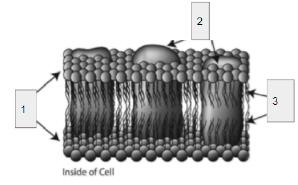 Identify part 1 of a Phospholipid
Bilayer? a. | Phosphate heads | b. | Protein | c. | Fatty Acid
Tails | d. | Cytoplasm |
|
|
|
23.
|
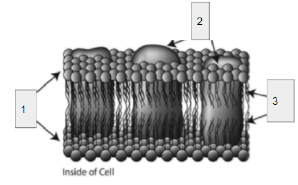 Identify part 1 of a Phospholipid
Bilayer? a. | Phosphate heads | b. | Protein | c. | Fatty Acid
Tails | d. | Cytoplasm |
|
|
|
24.
|
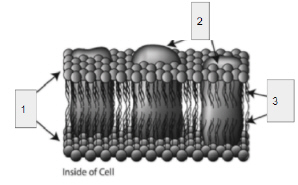 Identify part 1 of a Phospholipid
Bilayer? a. | Phosphate heads | b. | Protein | c. | Fatty Acid
Tails | d. | Cytoplasm |
|
|
|
25.
|
Which of the following is not a property of the cell membrane?
a. | regulate the movement of materials into and out of the cell | b. | composed of a
phospholipid bilayer | c. | semi-permeable which allows only certain
substancesl to pass through | d. | help to balance or maintain
homeostasis |
|
|
|
26.
|
Placing plant cells in a hypotonic solution causes the plant cell membranes to
shrink away from the cell wall.
a. | Osmosis | b. | Diffusion | c. | Plasmolysis | d. | Exocytosis |
|
|
|
27.
|
When the cell membrane folds itself around the substance, this cavity or sac is
called a _________?
a. | Vesicle | b. | Diffusion | c. | Plasmolysis | d. | Exocytosis |
|
|
|
28.
|
1. Material is removed from cell
2. Cell membrane opens up
3. A vesicle or
sac is formed around the unwanted material
4. The vesicle starts moving towards the cell
membrane
What order does exocytosis take place?
a. | 1,2,3,4 | b. | 1,3,4,2 | c. | 3,4,2,1 | d. | 4,3,2,1 |
|
|
|
29.
|
Which is NOT an example of active transport?
a. | Seagulls can drink salt water because their cells remove the excess salt from their
bodies | b. | Waste materials, proteins and fats being remove from the cell | c. | Blood cells use
carrier proteins transport molecules into the cell, but they have no mechanism to remove excess
water. | d. | Kidney dialysis, preserving food preserved by Salt, sugar curing or
pickling. |
|
|
|
30.
|
Which is an example of diffusion?
a. | Seagulls can drink salt water because their cells remove the excess salt from their
bodies | b. | Waste materials, proteins and fats being remove from the cell | c. | Blood cells use
carrier proteins transport molecules into the cell, but they have no mechanism to remove excess
water. | d. | Kidney dialysis, preserving food preserved by Salt, sugar curing or
pickling. |
|
|
|
31.
|
The movement of substances into and out of a cell without the use of energy is
called
a. | Active transport | b. | Passive transport | c. | Exocytosis | d. | Endocytosis |
|
|
|
32.
|
The movement of water across a semipermeable membrane from an area of high water
concentration to an area of low water concentration is called
a. | Active transport | b. | Passive transport | c. | Osmosis | d. | Hypotonic |
|
|
|
33.
|
A type of membrane which allows only certain molecules to pass through is called
a. | Hypertonic | b. | Semi-permeable | c. | Active
transport | d. | Porous |
|
|
|
34.
|
A cell placed in a solution shrinks by the process of osmosis. What kind of
solution is outside the cell?
a. | Hypertonic | b. | Hypotonic | c. | Active
transport | d. | Isotonic |
|
|
|
35.
|
If the solution surrounding a cell has a lower concentration of solutes than
inside the cell, water will move into the cell through osmosis, causing it to expand. What kind of
solution is surrounding the cell?
a. | Hypertonic | b. | Hypotonic | c. | Active
transport | d. | Isotonic |
|